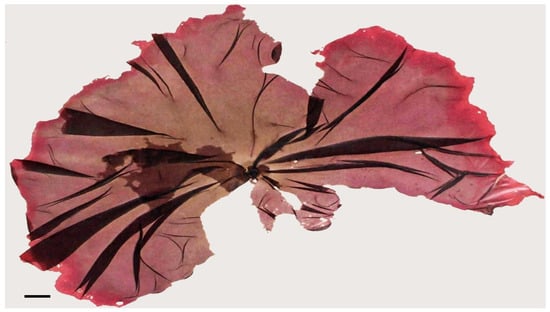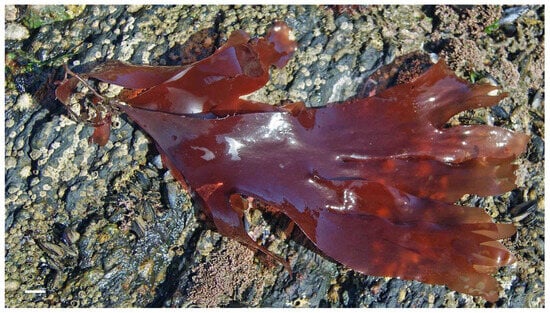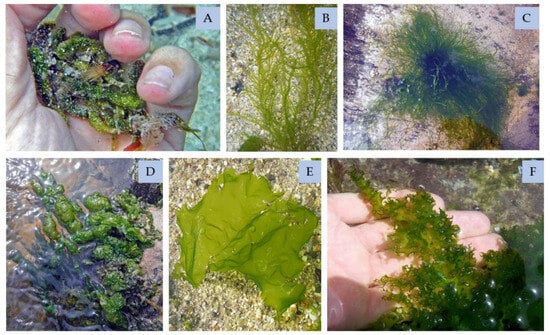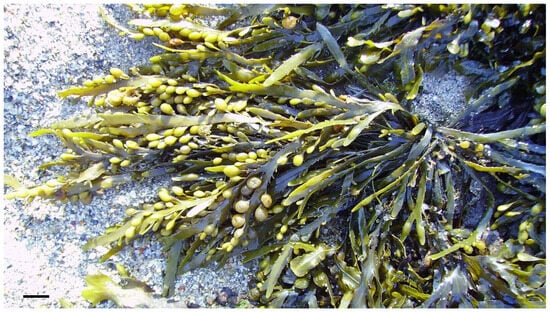
| Version | Summary | Created by | Modification | Content Size | Created at | Operation |
|---|---|---|---|---|---|---|
| 1 | Leonel Pereira | -- | 2131 | 2023-11-08 12:37:56 | | | |
| 2 | Sirius Huang | Meta information modification | 2131 | 2023-11-10 02:37:42 | | |
Video Upload Options
Diseases such as obesity; cardiovascular diseases such as high blood pressure, myocardial infarction and stroke; digestive diseases such as celiac disease; certain types of cancer and osteoporosis are related to food. On the other hand, as the world’s population increases, the ability of the current food production system to produce food consistently is at risk. As a result, intensive agriculture has contributed to climate change and a major environmental impact. Research is, therefore, needed to find new sustainable food sources. One of the most promising sources of sustainable food raw materials is macroalgae. Algae are crucial to solving this nutritional deficiency because they are abundant in bioactive substances that have been shown to combat diseases such as hyperglycemia, diabetes, obesity, metabolic disorders, neurodegenerative diseases and cardiovascular diseases.
1. Introduction
2. Algae Food Products as Healthcare Solution
2.1. Red Algae (Rhodophyta)


2.2. Green Algae (Chlorophyta)

2.3. Brown Algae (Phaeophyceae)
2.4. The Use of Macroalgae in Gluten-Free Products

References
- Alberti, K.G.M.; Zimmet, P.; Shaw, J. The Metabolic Syndrome—A New Worldwide Definition. Lancet 2005, 366, 1059–1062.
- Micha, R.; Peñalvo, J.L.; Cudhea, F.; Imamura, F.; Rehm, C.D.; Mozaffarian, D. Association Between Dietary Factors and Mortality From Heart Disease, Stroke, and Type 2 Diabetes in the United States. JAMA 2017, 317, 912.
- Micha, R.; Khatibzadeh, S.; Shi, P.; Andrews, K.G.; Engell, R.E.; Mozaffarian, D. Global, Regional and National Consumption of Major Food Groups in 1990 and 2010: A Systematic Analysis Including 266 Country-Specific Nutrition Surveys Worldwide. BMJ Open 2015, 5, e008705.
- Żarnowski, A.; Jankowski, M.; Gujski, M. Public Awareness of Diet-Related Diseases and Dietary Risk Factors: A 2022 Nationwide Cross-Sectional Survey among Adults in Poland. Nutrients 2022, 14, 3285.
- Willett, W.C.; Stampfer, M.J. Current Evidence on Healthy Eating. Annu. Rev. Public Health 2013, 34, 77–95.
- Leandro, A.; Pacheco, D.; Cotas, J.; Marques, J.C.; Pereira, L.; Gonçalves, A.M.M. Seaweed’s Bioactive Candidate Compounds to Food Industry and Global Food Security. Life 2020, 10, 140.
- Segal, L.; Opie, R.S. A Nutrition Strategy to Reduce the Burden of Diet Related Disease: Access to Dietician Services Must Complement Population Health Approaches. Front. Pharmacol. 2015, 6, 160.
- Vettor, R. The Right Nutrition for the Nutrition Related Diseases. Rev. Endocr. Metab. Disord. 2020, 21, 293–296.
- Cascais, M.; Monteiro, P.; Pacheco, D.; Cotas, J.; Pereira, L.; Marques, J.C.; Gonçalves, A.M.M. Effects of Heat Treatment Processes: Health Benefits and Risks to the Consumer. Appl. Sci. 2021, 11, 8740.
- Kılınç, B.; Cirik, S.; Turan, G.; Tekogul, H.; Koru, E.; Kılınç, B.; Cirik, S.; Turan, G.; Tekogul, H.; Koru, E. Seaweeds for Food and Industrial Applications. Chem. Age India 2013, 33, 475–482.
- Lomartire, S.; Gonçalves, A.M.M. An Overview of Potential Seaweed-Derived Bioactive Compounds for Pharmaceutical Applications. Mar. Drugs 2022, 20, 141.
- Parodi, A.; Leip, A.; De Boer, I.J.M.; Slegers, P.M.; Ziegler, F.; Temme, E.H.M.; Herrero, M.; Tuomisto, H.; Valin, H.; Van Middelaar, C.E.; et al. The Potential of Future Foods for Sustainable and Healthy Diets. Nat. Sustain. 2018, 1, 782–789.
- Shannon, E.; Abu-Ghannam, N. Seaweeds as Nutraceuticals for Health and Nutrition. Phycologia 2019, 58, 563–577.
- Bourgougnon, N.; Burlot, A.S.; Jacquin, A.G. Algae for Global Sustainability? Adv. Bot. Res. 2021, 100, 145–212.
- Pacheco, D.; Cotas, J.; Leandro, A.; Poza, S.G.; Gonçalves, A.M.M.; Pereira, L. Brown Seaweed Polysaccharides—A Roadmap as Biomolecules. In Seaweed Biotechnology; Apple Academic Press: Ontario, CA, USA, 2022.
- Derosa, G.; Pascuzzo, M.D.; D’angelo, A.; Maffioli, P. Ascophyllum Nodosum, Fucus Vesiculosus and Chromium Picolinate Nutraceutical Composition Can Help to Treat Type 2 Diabetic Patients. Diabetes Metab. Syndr. Obes. 2019, 12, 1861–1865.
- Guo, J.; Qi, M.; Chen, H.; Zhou, C.; Ruan, R.; Yan, X.; Cheng, P. Macroalgae-Derived Multifunctional Bioactive Substances: The Potential Applications for Food and Pharmaceuticals. Foods 2022, 11, 3455.
- Peñalver, R.; Lorenzo, J.M.; Ros, G.; Amarowicz, R.; Pateiro, M.; Nieto, G. Seaweeds as a Functional Ingredient for a Healthy Diet. Mar. Drugs 2020, 18, 301.
- Cardoso, C.; Almeida, J.; Coelho, I.; Delgado, I.; Gomes, R.; Quintã, R.; Bandarra, N.M.; Afonso, C. Farming a Wild Seaweed and Changes to Its Composition, Bioactivity, and Bioaccessibility: The Saccorhiza Polyschides Case Study. Aquaculture 2023, 566, 739217.
- Soares, C.; Švarc-Gajić, J.; Oliva-Teles, M.T.; Pinto, E.; Nastić, N.; Savić, S.; Almeida, A.; Delerue-Matos, C. Mineral Composition of Subcritical Water Extracts of Saccorhiza Polyschides, a Brown Seaweed Used as Fertilizer in the North of Portugal. J. Mar. Sci. Eng. 2020, 8, 244.
- Bocanegra, A.; Macho-González, A.; Garcimartín, A.; Benedí, J.; Sánchez-Muniz, F.J. Whole Alga, Algal Extracts, and Compounds as Ingredients of Functional Foods: Composition and Action Mechanism Relationships in the Prevention and Treatment of Type-2 Diabetes Mellitus. Int. J. Mol. Sci. 2021, 22, 3816.
- Leandro, A.; Pereira, L.; Gonçalves, A.M.M. Diverse Applications of Marine Macroalgae. Mar. Drugs 2019, 18, 17.
- Antunes, M. Estudo Bioquímico e Fisiológico Aplicado à Macroalga Saccorhiza Polyschides. Ph.D. Thesis, Instituto Politecnico de Leiria, Leiria, Portugal, 2021.
- Allsopp, P.; Crowe, W.; Bahar, B.; Harnedy, P.A.; Brown, E.S.; Taylor, S.S.; Smyth, T.J.; Soler-Vila, A.; Magee, P.J.; Gill, C.I.R.; et al. The Effect of Consuming Palmaria Palmata-Enriched Bread on Inflammatory Markers, Antioxidant Status, Lipid Profile and Thyroid Function in a Randomised Placebo-Controlled Intervention Trial in Healthy Adults. Eur. J. Nutr. 2016, 55, 1951–1962.
- Cotas, J.; Leandro, A.; Pacheco, D.; Gonçalves, A.M.M.; Pereira, L. A Comprehensive Review of the Nutraceutical and Therapeutic Applications of Red Seaweeds (Rhodophyta). Life 2020, 10, 19.
- Lähteenmäki-Uutela, A.; Rahikainen, M.; Camarena-Gómez, M.T.; Piiparinen, J.; Spilling, K.; Yang, B. European Union Legislation on Macroalgae Products. Aquac. Int. 2021, 29, 487–509.
- Mouritsen, O.G.; Dawczynski, C.; Duelund, L.; Jahreis, G.; Vetter, W.; Schröder, M. On the Human Consumption of the Red Seaweed Dulse (Palmaria Palmata (L.) Weber & Mohr). J. Appl. Phycol. 2013, 25, 1777–1791.
- Fitzgerald, C.; Gallagher, E.; Doran, L.; Auty, M.; Prieto, J.; Hayes, M. Increasing the Health Benefits of Bread: Assessment of the Physical and Sensory Qualities of Bread Formulated Using a Renin Inhibitory Palmaria Palmata Protein Hydrolysate. LWT-Food Sci. Technol. 2014, 56, 398–405.
- Gunathilaka, T.L.; Samarakoon, K.; Ranasinghe, P.; Peiris, L.D.C. Antidiabetic Potential of Marine Brown Algae—A Mini Review. J. Diabetes Res. 2020, 2020, 1230218.
- Senthilkumar, P.; Sellappa, S.; Prakash, S. Antidiabetic Activity of Aqueous Extract of Padina Boergesenii in Streptozotocin-Induced Diabetic Rats. Int. J. Pharm. Pharm. Sci. 2014, 6, 418–422.
- Akbarzadeh, S.; Gholampour, H.; Farzadinia, P.; Daneshi, A.; Ramavandi, B.; Moazzeni, A.; Keshavarz, M.; Bargahi, A. Anti-Diabetic Effects of Sargassum Oligocystum on Streptozotocin-Induced Diabetic Rat. Iran. J. Basic. Med. Sci. 2018, 21, 342.
- Różyło, R.; Hameed Hassoon, W.; Gawlik-Dziki, U.; Siastała, M.; Dziki, D. Study on the Physical and Antioxidant Properties of Gluten-Free Bread with Brown Algae. CyTA-J. Food 2017, 15, 196–203.
- Gotama, T.L.; Husni, A. Ustadi Antidiabetic Activity of Sargassum Hystrix Extracts in Streptozotocin-Induced Diabetic Rats. Prev. Nutr. Food Sci. 2018, 23, 189.
- Ścieszka, S.; Klewicka, E. Algae in Food: A General Review. Crit. Rev. Food Sci. Nutr. 2018, 59, 3538–3547.
- Fradinho, P.; Raymundo, A.; Sousa, I.; Domínguez, H.; Torres, M.D. Edible Brown Seaweed in Gluten-Free Pasta: Technological and Nutritional Evaluation. Foods 2019, 8, 622.
- Medvedeva, E.I.; Kalyuzhnaya, A.M.; Panchenko, A.K.; Krasil’nikova, S.V.; Petrenko, E.B. Amino Acids from Algae-Valuable Bread Additives. Khlebopekarnaya I Konditer. Promyshlennost 1969, 13, 16–17.
- Mamat, H.; Matanjun, P.; Ibrahim, S.; Siti, S.F.; Abdul Hamid, M.; Rameli, A.S. The Effect of Seaweed Composite Flour on the Textural Properties of Dough and Bread. J. Appl. Phycol. 2014, 26, 1057–1062.
- Menezes, B.S.; Coelho, M.; Rivero Meza, S.; Salas-Mellado, M.; Souza, M.R.A.Z. Macroalgal Biomass as an Additional Ingredient of Bread. Int. Food Res. J. 2015, 22, 819–824.
- Passos, R.; Correia, A.P.; Pires, D.; Pires, P.; Ferreira, I.; Simões, M.; do Carmo, B.; Santos, P.; Pombo, A.; Afonso, C.; et al. Potential Use of Macroalgae Gracilaria Gracilis in Diets for European Seabass (Dicentrarchus Labrax): Health Benefits from a Sustainable Source. Fish. Shellfish Immunol. 2021, 119, 105–113.




